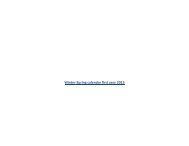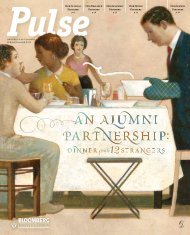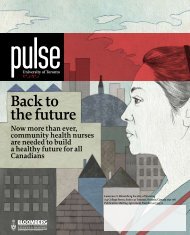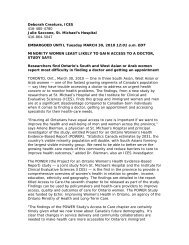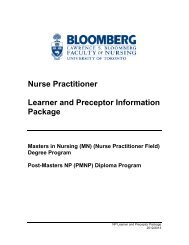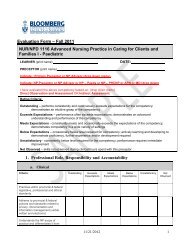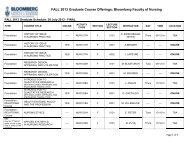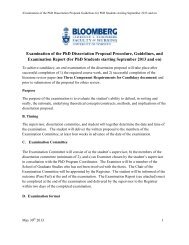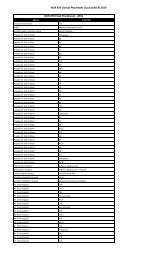Read more - Lawrence S. Bloomberg Faculty of Nursing - University ...
Read more - Lawrence S. Bloomberg Faculty of Nursing - University ...
Read more - Lawrence S. Bloomberg Faculty of Nursing - University ...
Create successful ePaper yourself
Turn your PDF publications into a flip-book with our unique Google optimized e-Paper software.
he’s developing a project focusing on improving the self-efcacy <strong>of</strong> people<br />
with severe refractory angina, like Audrey Smith.<br />
“Refractory angina is constant, debilitating pain and this poses unique<br />
management challenges to cardiovascular clinicians, patients and families. This<br />
pain can arise or persist in the absence <strong>of</strong> any notable lack <strong>of</strong> oxygen to the heart,<br />
<strong>of</strong>ten as the result <strong>of</strong> damage to the nervous system,” says McGillion. “Patients living<br />
with refractory angina suffer major psychological distress. Like any chronic<br />
pain it can become all-consuming, and take over your life. It’s debilitating for<br />
people because they’re afraid to engage in physical activity,” says McGillion. “So,<br />
as researchers, the question is how can we improve access to expert refractory<br />
angina pain-related care, and enhance a person’s self-efcacy”<br />
McGillion may have some answers. Collaborating with Swedish colleagues,<br />
he wants to launch a trial using the chronic angina self-management program<br />
together with spinal cord stimulation, one <strong>of</strong> the therapies for refractory<br />
angina and other kinds <strong>of</strong> chronic pain. Spinal cord stimulation involves a<br />
pulse generator implant in the chest and electrical wires to the spinal cord.<br />
This stimulation serves to distract the brain from pain stemming in the cardiac<br />
region. It also serves to increase blood ow—and oxygen—to the heart. Would<br />
this combination <strong>of</strong> cognitive and physical therapies help people function<br />
better in their day-to-day life<br />
It’s a question well worth asking because unrelieved pain has major consequences.<br />
People become sedentary, which causes a whole host <strong>of</strong> other<br />
health problems. There are nancial costs as well—about $19,000 per year,<br />
per person suffering from angina, according to one Ontario-based study,<br />
says McGillion.<br />
And while strong evidence supports the prevalence <strong>of</strong> chronic refractory<br />
angina is rising globally, “there’s a real decit in the understanding<br />
<strong>of</strong> cardiovascular pain,” he says. “The real problem is effective refractory<br />
angina management requires knowledge and application <strong>of</strong> pain and cardiovascular<br />
mechanisms. Unfortunately an integrated understanding <strong>of</strong> these<br />
perspectives is not common among clinicians. We don’t have the pain and<br />
the cardiac communities working together <strong>more</strong> broadly on this issue.” That<br />
is, until now.<br />
McGillion wants to bridge this knowledge gap, particularly from the<br />
nursing perspective. He’s working with pain and cardiovascular experts on<br />
a plan for national practice guidelines to help health-care pr<strong>of</strong>essionals<br />
assess and manage chronic refractory angina. McGillion aims to produce a<br />
patient version as well, to empower angina sufferers, like Audrey Smith, to<br />
make better decisions about when to access emergency services and how to<br />
optimize their quality <strong>of</strong> life.<br />
*name withheld by request<br />
don’t be a martyr—take your pain relief meds<br />
You would think people suffering from pain after a grueling three to ve-hour<br />
cardiac surgery, where their sternum was cut and they were immobile for the<br />
duration, with arms outstretched, would be diligent in taking their pain medication.<br />
Think again. For a variety <strong>of</strong> reasons, Dr. Marit Leegaard found many women in her<br />
post-operative study did not always follow their health-care provider’s advice.<br />
“It’s the inside (<strong>of</strong> the chest) that is most painful, and the pain keeps me up most <strong>of</strong><br />
the night.”<br />
For her PhD thesis at the <strong>University</strong> <strong>of</strong> Oslo, Leegaard researched the<br />
self-management <strong>of</strong> post-operative cardiac pain in a qualitative study <strong>of</strong> 10<br />
Norwegian women. She selected women because cardiovascular disease is the<br />
No. 1 killer <strong>of</strong> women, and also because it’s believed women report <strong>more</strong> postoperative<br />
pain than men after cardiac surgery.<br />
The women were interviewed in their homes eight to 14 days after their<br />
surgery, and were required to ll in a diary tracking their pain levels every<br />
day—how much, where, and what they used for relief. The pain intensity was<br />
determined by taking an average <strong>of</strong> the last 24 hours and current levels. For<br />
pain medication, the women were advised one to two tablets (500 mg each) <strong>of</strong><br />
acetaminophen, two to four times daily in the rst few weeks at home. They also<br />
had a prescription <strong>of</strong> a stronger version to use “as required” when experiencing<br />
their worst pain: acetaminophen tablets with 30 mg <strong>of</strong> codeine. This information<br />
was available in booklet form for the women as well.<br />
At their time <strong>of</strong> discharge, patients in Leegaard’s study were informed about<br />
their surgical wounds, medication, physical activity and restrictions, and about<br />
issues such as mood, diet and smoking, as per standard procedure. “Their<br />
knowledge and expectations <strong>of</strong> pain made self-management easier, because<br />
they knew they would have increased pain in the chest,” says Leegaard. “But they<br />
didn’t expect pain in their neck and shoulders.” She adds: “They only used their<br />
knowledge <strong>of</strong> pain gained before their hospital discharge.”<br />
“I can still feel the wire (used to stitch the sternum split) inside my chest.”<br />
Dr. Marit Leegaard believes post-operative pain from cardiac surgery should<br />
<strong>Lawrence</strong> S. <strong>Bloomberg</strong> <strong>Faculty</strong> <strong>of</strong> <strong>Nursing</strong><br />
19



